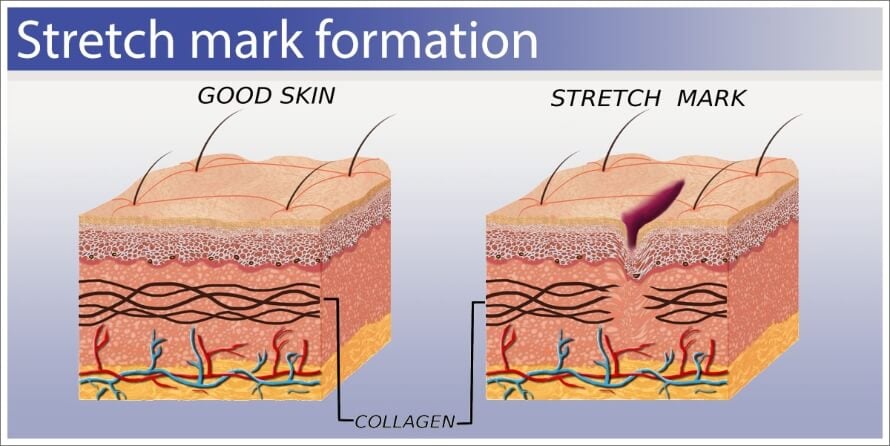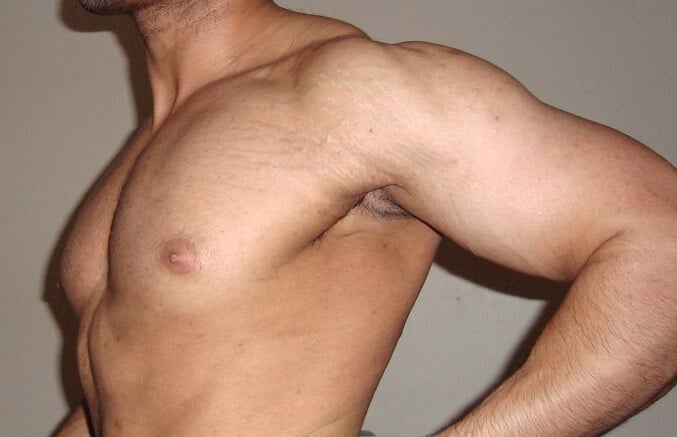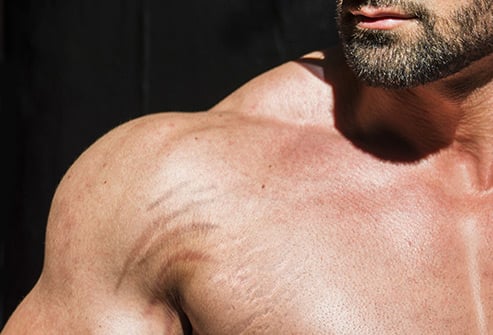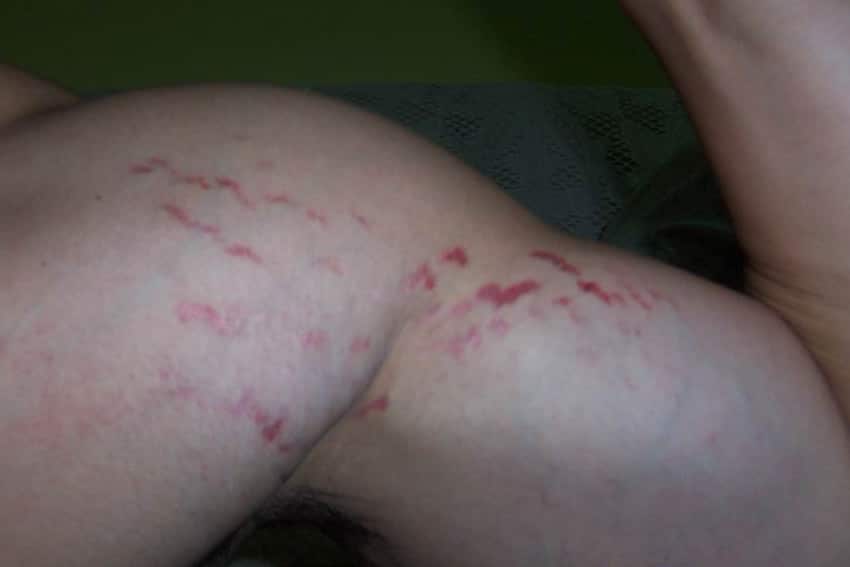If you have muscle stretch marks and want to get rid of them, I have good and bad news for you.
The good news is that stretch marks tend to fade and become less visible over time, and that there probably wasn’t anything you could have done to avoid them.
In fact, if you have stretch marks from working out, it’s probably a sign you’ve gained a fair amount of muscle—which is great!
The bad news is that stretch marks are semi-permanent. You can’t completely get rid of them, no matter how many creams, laser treatments, or other nostrums you try.
In most cases, the best thing you can do is accept stretch marks as little emblems that attest to the hard work you’ve put into transforming your body into something special.
That said, there are a few things you can do to make sure stretch marks don’t get worse, and some treatments that might slightly reduce the visibility of any stretch marks you already have.
In this article, you’ll learn what stretch marks are, what causes stretch marks from muscle growth, why some people get them and some don’t, and what you can (and can’t) do to make them less obvious.
What Are Muscle Stretch Marks?

Stretch marks are linear, smooth scars in the skin caused by injury or degeneration of the cartilage in your skin.
Depending on skin color, they can be red or purple and fade over time to a pale, silvery hue.
Muscle stretch marks are caused by an increase in the size of the muscles that lie underneath the skin, and most commonly appear on the biceps, shoulders, and glutes. They often appear as a set of faint, curved, parallel “tiger claw” scratches located right above the armpit:

Here’s another shot of what stretch marks on the shoulders look like:

And here’s what stretch marks on the biceps typically look like:

Stretch marks also commonly occur on the back, abdomen, breast, hips, and thighs, and tend to be more common in women than in men.
What Causes Stretch Marks on Biceps and Shoulders?
Anything that causes a sudden expansion of the skin can cause stretch marks. Some of the most common causes are . . .
- Significant weight gain or loss
- Puberty
- Pregnancy
By far, the most common cause of stretch marks is simply gaining too much body fat, which stretches the skin far beyond its natural dimensions. As the skin expands, it develops microscopic tears that allow it to accommodate the increase in fat tissue.
You can think of your skin like plastic wrap covering your muscles. Although you can stretch it slightly and it’ll snap back into place, if you stretch it far enough, it’ll develop permanent weak points.
The same thing is true when you gain large amounts of muscle mass. As your muscles grow, they press against the skin covering them, and in some cases this pressure can be enough to cause stretch marks.
Stretch marks can also occur naturally as a result of puberty. As your bones, muscles, and organs grow larger, your skin may not grow fast enough to keep up with the added volume, which can also cause stretch marks.
So, why do stretch marks often appear on the biceps and shoulders?
No one knows for sure, but the answer is likely that the skin in these areas is particularly prone to stretching and tearing.
Another likely explanation is that many guys develop stretch marks on many areas of their body, but that stretch marks on the biceps and shoulders tend to be more obvious. That is, stretch marks may not be more common on the biceps and shoulders than other parts of the body, but are just more noticeable.
How to Prevent Stretch Marks from Working Out
Some people claim that you can avoid muscle stretch marks by intentionally gaining muscle slowly or even not training muscles underneath skin that’s developing stretch marks.
While this seems logical at first blush, it’s nonsensical for a few reasons.
First of all, it’s not clear whether the rate or amount of weight gain is what causes stretch marks. That is, it’s quite possible that once your muscles reach a certain size, you’ll get stretch marks regardless of how quickly or slowly they grow. If this is true, your only way to avoid getting muscle stretch marks would be to simply not gain muscle, which isn’t a tradeoff most guys want to make.
For argument’s sake, though, let’s say that gaining weight quickly does increase the risk of stretch marks. In this case, deliberately trying to gain muscle slowly is still silly.
The reason for this is that unless you’re taking steroids, muscle growth is a slow, laborious process, and it takes most men at least three to five years to realize their genetic potential for muscle gain. In short, muscle growth is always going to be slow regardless of how you eat or train as a natural weightlifter.
More specifically, most guys can gain around 20 pounds of muscle in their first year of proper weightlifting (about 1.5 pounds per month); about 10 pounds the second year; about 5 pounds the third year, and from there on they’re lucky to gain a pound or two per year. (Curious how much muscle you can gain? Check out the Legion Muscle Gain Potential Calculator).
Even during your first year of weightlifting, when you’re building muscle faster than you ever will again, you’re still only gaining 1.5 pounds per month. And if that’s all it takes to get muscle stretch marks, they were probably just in your genetic cards to begin with.
Unless you’re taking steroids, gaining an appreciable amount of muscle is always going to take months and years, which should be ample time for your skin to adjust. The reality is that once you develop a certain amount of muscle mass, you’re probably going to get stretch marks regardless of how slowly you build muscle.
There’s also another explanation for why some people get stretch marks and some don’t: how much fat they gain while bulking.
Driven by unrealistic expectations, bad habits, or poor advice from fitness gurus, many people who bulk incorrectly put on two or three pounds of fat for every pound of muscle they gain. For example, someone might gain 20 pounds of muscle but also gain 40 pounds of fat during a bulk, putting their total weight gain at 60 pounds in a matter of months. This is an extreme example, but I’ve seen it happen.
In other words, they gained way more weight than they needed to, and thus their skin had to expand to accommodate their extra bulk.
In many cases, though, the stretch marks aren’t immediately obvious, and so many people don’t realize them until they lose much of the weight they’ve gained on one of these “dirty bulks.” Then, once they’ve lost much of the weight, some people assume the resulting stretch marks were from gaining muscle, when they were really from gaining far too much fat.
And what about people who have stretch marks who’ve never been overweight or dirty bulked?
In these cases, the culprit is likely genetics. Either they experienced a very aggressive growth spurt during puberty which caused stretch marks or their skin was simply more susceptible to them in adult life.
So, what can you do to avoid stretch marks? Here are four things that might help.
Maintain a healthy body weight.
The best way to avoid stretch marks is to keep your body fat percentage in a healthy range. For men, this means staying between 8 to 17% body fat and for women it means staying between 15 to 25% body fat.
Do that, and your chances of developing stretch marks drops significantly.
Avoid rapid increases or decreases in body weight.
Gaining muscle quickly probably doesn’t increase your risk of stretch marks, but gaining muscle along with lots of body fat probably does.
If you’ve been weightlifting for a year or less and are gaining weight faster than about 1.5% of your body weight per month, you’re probably gaining more fat than you should be, which significantly increases your risk of stretch marks. If you’ve been lifting weights for more than a year, you should aim to gain weight no faster than about 0.5 to 1% of your body weight per month.
Eat a nutritious diet.
Getting adequate vitamins A and C and zinc and silicon are particularly important for skin health.
If you’d like to ensure you don’t have any nutritional “holes” in your diet, try Triumph, a sport multivitamin that enhances health, performance, and mood; and reduces stress, fatigue, and anxiety.
Can You Get Rid of Stretch Marks from Working Out?
Not really.
Unfortunately, stretch marks are impossible to remove entirely. Although you’ll find many people recommending various creams, ointments, and other embrocations for getting rid of stretch marks, there’s little evidence these treatments work.
The reason for this is that stretch marks are a form of deep scarring that affects multiple layers of skin. Thus, rubbing a cream on the outermost layer doesn’t do anything to remove the scarring under the surface.
That said, research shows that some treatments may slightly reduce the appearance of stretch marks, so let’s quickly review both the good and bad.
Stretch Mark Creams
Creams can help with skin dryness and reduce itching, but research shows they’re generally ineffective for reducing or preventing stretch marks. There is very weak evidence that the topical application of hyaluronic acid—which can be found in some stretch mark creams—may help prevent stretch marks, but don’t count on it.
Cocoa Butter
Cocoa butter is a fatty substance obtained from cocoa beans that’s long been a folk remedy for preventing stretch marks. Unfortunately, it’s a dud. Studies show that it doesn’t reduce the likelihood of developing stretch marks.
Bitter Almond Oil
Bitter almond oil is oil extracted from almonds produced by the bitter almond tree. A study conducted by scientists at Inonu University in Turkey found that pregnant women who received a massage with bitter almond oil developed fewer stretch marks than women who received a regular massage and women who were rubbed with the oil but didn’t get a massage.
That said, the results have yet to be replicated and smell a bit fishy (why would the oil not help at all without the massage?).
Silicone Gel
A study conducted by scientists at the University of Manchester found that subjects who massaged silicone gel into their abdomen daily for 6 weeks reduced stretch mark pigmentation, so there might be some merit in giving it a shot.
Olive Oil
Research shows that applying olive oil to the affected area of the body doesn’t reduce the likelihood of developing stretch marks. That said, one study found that applying olive oil topically twice per day can reduce the incidence of severe stretch marks, so it might be worth trying (especially considering how inexpensive it is compared to the other options).
Gotu Kola
Gotu Kola is a medicinal plant that has been in use for hundreds of years. Research shows that regular topical application of Gotu Kola may be able improve a variety of skin conditions, including stretch marks, cellulite, and scarring in general.
Retinoic Acid
Retinoic acid is a compound derived from vitamin A, and it’s used in creams like Tretinoin to rebuild collagen in the skin and thus improve the appearance of early stretch marks (the pink, first-stage lines) and acne. Research shows that it may help reduce the severity of stretch marks, but it shouldn’t be used by pregnant or breastfeeding women because it can cause birth defects.
Microdermabrasion
Microdermabrasion is a process whereby crystals are blown onto the skin and vacuumed away, “polishing” its surface. It gently removes the top layer of the skin, which stimulates the growth of new, smooth skin. Research shows it may be able to improve the appearance of early stretch marks.
Laser Therapy
Laser therapy uses different wavelengths of light to stimulate the production of collagen, elastin, or melanin in the skin. Studies show that laser therapy is a safe, effective way to improve the appearance of both early (red) and late (white) stretch marks.
There are many types of lasers that can be used effectively, such as the 1,064-nm Nd:YAG laser, 1540-nm fractional nonablative laser, and 1550-nm fractional nonablative laser, so talk with your doctor as to which is most suitable to your condition. Remember, though, that there’s still no evidence that laser therapy can completely remove stretch marks, only make them less visible.
Intense Pulsed Light (IPL)
IPL is a skin therapy that involves, as you can guess, pulsing the skin with a high-powered light.
Similar to laser therapy, the light and heat are used to destroy certain structures in the skin so they can be rebuilt.
Whereas laser therapy uses only one wavelength of light, though, IPL uses filters to switch between a broad spectrum of wavelengths. Several studies show that IPL is a safe and effective treatment for reducing the appearance of stretch marks.
The Right Way to Think About Muscle Stretch Marks
Many, many people have stretch marks.
I’d even go so far as to say that most of the people I’ve met who’ve gained a significant amount of muscle have at least a few of these little silvery streaks somewhere on their body, and that’s fine.
If you have stretch marks after losing weight, then look at them as emblems of what you were able to accomplish with your body. They’re little reminders of how far you’ve come.
If you have stretch marks after gaining muscle, look at them as battle scars from building a body you can be proud of—totems to your own personal transformation. And if that doesn’t help, just think of them as a small sacrifice you had to make on the altar of gains. 🙂
And if you have stretch marks from puberty or genetics, chalk them up to one of the many irksome vagaries of life that are out of your control and ultimately just aren’t that important. Focus on the things you can control, improve, and master, not minor, immutable nuisances like stretch marks.
Scientific References +
- Shokeir, H., El Bedewi, A., Sayed, S., & El Khalafawy, G. (2014). Efficacy of pulsed dye laser versus intense pulsed light in the treatment of striae distensae. Dermatologic Surgery, 40(6), 632–640. https://doi.org/10.1111/dsu.0000000000000007
- Al-Dhalimi, M. A., & Abo Nasyria, A. A. (2013). A comparative study of the effectiveness of intense pulsed light wavelengths (650 nm vs 590 nm) in the treatment of striae distensae. Journal of Cosmetic and Laser Therapy, 15(3), 120–125. https://doi.org/10.3109/14764172.2012.748200
- Hernández-Pérez, E., Colombo-Charrier, E., & Valencia-Ibiett, E. (2002). Intense pulsed light in the treatment of striae distensae. Dermatologic Surgery, 28(12), 1124–1130. https://doi.org/10.1046/j.1524-4725.2002.02111.x
- Yang, Y. J., & Lee, G. Y. (2011). Treatment of striae distensae with nonablative fractional laser versus ablative CO2 fractional laser: A randomized controlled trial. Annals of Dermatology, 23(4), 481–489. https://doi.org/10.5021/ad.2011.23.4.481
- De Angelis, F., Kolesnikova, L., Renato, F., & Liguori, G. (2011). Fractional nonablative 1540-nm laser treatment of striae distensae in Fitzpatrick skin types II to IV: Clinical and histological results. Aesthetic Surgery Journal, 31(4), 411–419. https://doi.org/10.1177/1090820X11402493
- Goldman, A., Rossato, F., & Prati, C. (2008). Stretch marks: Treatment using the 1,064-nm Nd:YAG laser. Dermatologic Surgery, 34(5), 686–692. https://doi.org/10.1111/j.1524-4725.2008.34129.x
- Suh, D. H., Chang, K. Y., Son, H. C., Ryu, J. H., Lee, S. J., & Song, K. Y. (2007). Radiofrequency and 585-nm pulsed dye laser treatment of striae distensae: A report of 37 Asian patients. Dermatologic Surgery, 33(1), 29–34. https://doi.org/10.1111/j.1524-4725.2007.33004.x
- McDaniel, D. H. (2002). Laser therapy of stretch marks. In Dermatologic Clinics (Vol. 20, Issue 1, pp. 67–76). W.B. Saunders. https://doi.org/10.1016/S0733-8635(03)00046-9
- Karimipour, D. J., Karimipour, G., & Orringer, J. S. (2010). Microdermabrasion: An evidence-based review. In Plastic and Reconstructive Surgery (Vol. 125, Issue 1, pp. 372–377). Plast Reconstr Surg. https://doi.org/10.1097/PRS.0b013e3181c2a583
- Nau, H. (2001). Teratogenicity of isotretinoin revisited: Species variation and the role of all-trans-retinoic acid. Journal of the American Academy of Dermatology, 45(5). https://doi.org/10.1067/mjd.2001.113720
- ELSON, M. L. (1990). Treatment of Striae Distensae with Topical Tretinoin. The Journal of Dermatologic Surgery and Oncology, 16(3), 267–270. https://doi.org/10.1111/j.1524-4725.1990.tb03962.x
- Bulengo-Ransby, S. M., Griffiths, C., Kimbrough-Green, C. K., Finkel, L. J., Hamilton, T. A., Ellis, C. N., & Voorhees, J. J. (1993). Topical Tretinoin (Retinoic Acid) Therapy for Hyperpigmented Lesions Caused by Inflammation of the Skin in Black Patients. New England Journal of Medicine, 328(20), 1438–1443. https://doi.org/10.1056/nejm199305203282002
- Bylka, W., Znajdek-Awizeń, P., Studzińska-Sroka, E., & Brzezińska, M. (2013). Centella asiatica in cosmetology. In Postepy Dermatologii i Alergologii (Vol. 30, Issue 1, pp. 46–49). Postepy Dermatol Alergol. https://doi.org/10.5114/pdia.2013.33378
- Soltanipoor, F., Delaram, M., Taavoni, S., & Haghani, H. (2012). The effect of olive oil on prevention of striae gravidarum: A randomized controlled clinical trial. Complementary Therapies in Medicine, 20(5), 263–266. https://doi.org/10.1016/j.ctim.2012.05.001
- Taavoni, S., Soltanipour, F., Haghani, H., Ansarian, H., & Kheirkhah, M. (2011). Effects of olive oil on striae gravidarum in the second trimester of pregnancy. Complementary Therapies in Clinical Practice, 17(3), 167–169. https://doi.org/10.1016/j.ctcp.2010.10.003
- Ud-Din, S., McAnelly, S. L., Bowring, A., Whiteside, S., Morris, J., Chaudhry, I., & Bayat, A. (2013). A double-blind controlled clinical trial assessing the effect of topical gels on striae distensae (stretch marks): A non-invasive imaging, morphological and immunohistochemical study. Archives of Dermatological Research, 305(7), 603–617. https://doi.org/10.1007/s00403-013-1336-7
- Timur Taşhan, S., & Kafkasli, A. (2012). The effect of bitter almond oil and massaging on striae gravidarum in primiparaous women. Journal of Clinical Nursing, 21(11–12), 1570–1576. https://doi.org/10.1111/j.1365-2702.2012.04087.x
- Buchanan, K., Fletcher, H. M., & Reid, M. (2010). Prevention of striae gravidarum with cocoa butter cream. International Journal of Gynecology and Obstetrics, 108(1), 65–68. https://doi.org/10.1016/j.ijgo.2009.08.008
- Osman, H., Usta, I. M., Rubeiz, N., Abu-Rustum, R., Charara, I., & Nassar, A. H. (2008). Cocoa butter lotion for prevention of striae gravidarum: A double-blind, randomised and placebo-controlled trial. BJOG: An International Journal of Obstetrics and Gynaecology, 115(9), 1138–1142. https://doi.org/10.1111/j.1471-0528.2008.01796.x
- Korgavkar, K., & Wang, F. (2015). Stretch marks during pregnancy: A review of topical prevention. British Journal of Dermatology, 172(3), 606–615. https://doi.org/10.1111/bjd.13426
- McAvoy, B. R. (2013). No evidence for topical preparations in preventing stretch marks in pregnancy. In British Journal of General Practice (Vol. 63, Issue 609, p. 212). Royal College of General Practitioners. https://doi.org/10.3399/bjgp13X665431
- Brennan, M., Young, G., & Devane, D. (2012). Topical preparations for preventing stretch marks in pregnancy. Cochrane Database of Systematic Reviews, 11. https://doi.org/10.1002/14651858.cd000066.pub2
- Elsaie, M. L., Baumann, L. S., & Elsaaiee, L. T. (2009). Striae distensae (Stretch Marks) and different modalities of therapy: An update. In Dermatologic Surgery (Vol. 35, Issue 4, pp. 563–573). Dermatol Surg. https://doi.org/10.1111/j.1524-4725.2009.01094.x










